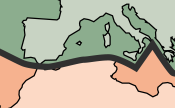Atlas Mountains
Atlas Mountains
The Atlas Mountains are a mountain range in Northwest Africa. Stretching through Morocco, Algeria, and Tunisia, the Atlas Mountains separate the Atlantic Ocean and Mediterranean Sea from the Sahara Desert. The range's highest peak is Toubkal, located in southwestern Morocco, standing at 4,167 meters (13,671 feet) above sea level. The Atlas Mountains are not only significant for their geographical and environmental importance but also for their cultural and historical significance to the Berber people, the indigenous inhabitants of the region.
Geography[edit | edit source]
The Atlas Mountains are divided into three main ranges: the High Atlas, the Middle Atlas, and the Anti-Atlas. Each range has its unique ecological system, with the High Atlas being the most prominent and home to the highest peaks. The region is characterized by a series of plateaus and valleys, with several rivers originating from the mountains, providing vital water resources for the surrounding areas.
Geology[edit | edit source]
The formation of the Atlas Mountains is linked to the collision of the African and Eurasian tectonic plates, which began in the late Jurassic period. This geological activity has resulted in a diverse landscape of rugged mountains, deep valleys, and rich mineral deposits. The mountains are also known for their fossils, which have provided valuable insights into the prehistoric life that once existed in the region.
Climate[edit | edit source]
The climate of the Atlas Mountains varies significantly with elevation and location. The lower slopes of the mountains experience a Mediterranean climate, with wet winters and hot, dry summers. Higher elevations have a mountain climate, with colder temperatures and more precipitation, which supports the growth of a variety of flora and fauna.
Flora and Fauna[edit | edit source]
The diverse climates and isolated locations of the Atlas Mountains have led to a high level of biodiversity. The region is home to a variety of endemic species, including the Atlas cedar, the Barbary macaque, and the Atlas mountain viper. The mountains also serve as a refuge for several species that are rare or endangered elsewhere.
Cultural Significance[edit | edit source]
The Atlas Mountains have been inhabited by the Berber people for thousands of years. The Berbers have developed a unique culture, with their own language, customs, and traditional architecture that is adapted to the mountainous terrain. The mountains have also played a significant role in the history of the region, serving as a natural fortress for local populations against invaders.
Tourism[edit | edit source]
Tourism is an increasingly important part of the economy in the Atlas Mountains. The region offers a wide range of outdoor activities, including hiking, skiing, and mountain biking. The High Atlas, in particular, is a popular destination for trekkers, who are drawn to its challenging trails and stunning landscapes. The mountains are also home to several traditional Berber villages, which offer insights into the local culture and way of life.
Conservation[edit | edit source]
The unique ecosystems of the Atlas Mountains are under threat from climate change, deforestation, and overgrazing. Conservation efforts are underway to protect the natural environment and promote sustainable practices among the local communities. These efforts include the establishment of national parks and protected areas, as well as initiatives to promote eco-tourism and environmental education.
Search WikiMD
Ad.Tired of being Overweight? Try W8MD's physician weight loss program.
Semaglutide (Ozempic / Wegovy and Tirzepatide (Mounjaro / Zepbound) available.
Advertise on WikiMD
|
WikiMD's Wellness Encyclopedia |
| Let Food Be Thy Medicine Medicine Thy Food - Hippocrates |
Translate this page: - East Asian
中文,
日本,
한국어,
South Asian
हिन्दी,
தமிழ்,
తెలుగు,
Urdu,
ಕನ್ನಡ,
Southeast Asian
Indonesian,
Vietnamese,
Thai,
မြန်မာဘာသာ,
বাংলা
European
español,
Deutsch,
français,
Greek,
português do Brasil,
polski,
română,
русский,
Nederlands,
norsk,
svenska,
suomi,
Italian
Middle Eastern & African
عربى,
Turkish,
Persian,
Hebrew,
Afrikaans,
isiZulu,
Kiswahili,
Other
Bulgarian,
Hungarian,
Czech,
Swedish,
മലയാളം,
मराठी,
ਪੰਜਾਬੀ,
ગુજરાતી,
Portuguese,
Ukrainian
Medical Disclaimer: WikiMD is not a substitute for professional medical advice. The information on WikiMD is provided as an information resource only, may be incorrect, outdated or misleading, and is not to be used or relied on for any diagnostic or treatment purposes. Please consult your health care provider before making any healthcare decisions or for guidance about a specific medical condition. WikiMD expressly disclaims responsibility, and shall have no liability, for any damages, loss, injury, or liability whatsoever suffered as a result of your reliance on the information contained in this site. By visiting this site you agree to the foregoing terms and conditions, which may from time to time be changed or supplemented by WikiMD. If you do not agree to the foregoing terms and conditions, you should not enter or use this site. See full disclaimer.
Credits:Most images are courtesy of Wikimedia commons, and templates, categories Wikipedia, licensed under CC BY SA or similar.
Contributors: Prab R. Tumpati, MD





